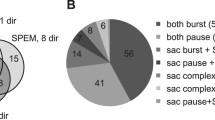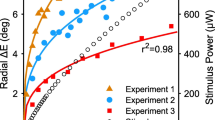Abstract
Saccade-related Purkinje cells (PCs) were recorded in the oculomotor vermis (lobules VI, VII) during spontaneous eye movements and fast phases of optokinetic and vestibular nystagmus in the light and darkness, from two macaque monkeys. All neurons (n=46) were spontaneously active and exhibited a saccade-related change of activity with all saccades and fast phases of nystagmus. Four types of neurons were found: most neurons (n=31) exhibited a saccade-related burst of activity only (VBN); other units (n=7) showed a burst of activity with a subsequent pause (VBPN); some of the units (n=5) paused in relation to the saccadic eye movement (pause units,VPN); a few PCs (n=3) showed a burst of activity in one direction and a pause of activity in the opposite direction. For all neurons, burst activity varied considerably for similar saccades. There were no activity differences between spontaneous saccades and vestibular or optokinetically elicited fast phases of nystagmus. The activity before, during, and after horizontal saccades was quantitatively analyzed. For 24 burst PCs (VBN, VBPN), the burst started before saccade onset in one horizontal direction (preferred direction), on average by 15.3 ms (range 27-5 ms). For all these neurons, burst activity started later in the opposite (non-preferred) direction, on average 4.9 ms (range 20 to -12 ms, P<0.01) before saccade onset. The preferred direction could be either with ipsilateral (42% of neurons) or contralateral (58%) saccades. Nine burst PCs had similar latencies and burst patterns in both horizontal directions. The onset of burst activity of a minority of PCs (n=5) lagged saccade onset in all directions. The pause for VBPN neurons started after the end of the saccade and reached a minimum of activity some 40–50 ms after saccade completion. For all saccades and quick phases of nystagmus, burst duration increased with saccade duration. Peak burst activity was not correlated with saccade amplitude or peak eye velocity. PCs continued to show saccade-related burst activity in the dark. However, in 59% of the PCs (VBN, VBPN), peak burst activity was significantly reduced in the dark (on average 28%, range 15–36%) when saccades with the same amplitude (but longer duration in the dark) were compared. For VBP neurons, the pause component after the saccade disappeared in the dark. The difference in peak burst activity (light vs darkness) is similar to that seen for saccade-related neurons in the fastigial oculomotor region (FOR, the structure receiving direct input from vermal PCs) and suggests that the oculomotor vermis also might affect saccade acceleration and/or deceleration. The findings indicate that in the oculomotor vermis — in contrast to the FOR — several different types of saccade-related neurons (PCs) are found. However, the vast majority of PCs behave qualitatively similar to FOR neurons with regard to the burst activity pattern and a direction-specific burst activity onset starting well before saccade onset. This latency will allow these neurons to influence the initiation of saccades in the saccadic brainstem generator through multisynaptic pathways. At present, it has to be determined how (saccade-related) PC activity determines FOR activity.
Similar content being viewed by others
References
Aschoff JC, Cohen B (1971) Changes in saccadic eye movements produced by cerebellar lesions. Exp Neurol 32:123–133
Bahill AT, Brockenbrough A, Troost BT (1981) Variability and development of a normative data base for saccadic eye movements. Invest Ophthalmol 21:116–125
Bon L, Lucchetti C (1988) The motor programs of monkeys' saccades: an attentional hypothesis. Exp Brain Res 71:199–207
Boyle R, Büttner U, Markert G (1985) Vestibular nuclei activity and eye movements in the alert monkey during sinusoidal optokinetic stimulation. Exp Brain Res 57:362–369
Büttner U, Büttner-Ennever JA (1988) Present concepts of oculomotor organization. Rev Oculomot Res 2:3–32
Crandall WF, Keller EL (1985) Visual and oculomotor signals in nucleus reticularis tegmenti pontis in alert monkey. J Neurophysiol 54:1326–1345
Fuchs AF, Robinson FR, Straube A (1993) Role of the caudal fastigial nucleus in saccade generation. I. Neuronal discharge patterns. J Neurophysiol 70:1723–1740
Gonshor A, Malcolm R (1971) Effect of changes in illumination level on electro-oculography (EOG). Aerospace Med 42:138–140
Helmchen C, Straube A, Büttner U (1994) Saccade-related activity in the fastigial oculomotor region of the macaque monkey during spontaneous eye movements in light and darkness. Exp Brain Res 98:474–482
Hepp K, Henn V, Vilis T, Cohen B (1989) Brainstem regions related to saccade generation. In: Wurtz B, Goldberg M (eds) The neurobiology of saccadic eye movements. Elsevier Science, pp 105–212
Ito M (1984) The cerebellum and the neural control. Raven, New York
Judge SJ, Richmond BJ, Chu FC (1980) Implantation of magnetic search coils for measurement of eye position: an improved method. Vision Res 20:535–538
Kase M, Miller DC, Noda H (1980) Discharges of Purkinje cells and mossy fibres in the cerebellar vermis of the monkey during saccadic eye movements and fixation. J Physiol (Lond) 300:539–555
Keller EL (1974) Participation of medial pontine reticular formation in eye movement generation in the monkey. J Neurophysiol 37:316–332
Keller EL (1989) The cerebellum. In: Wurtz B, Goldberg M (Eds) The neurobiology of eye movements. Elsevier Science, pp 391–411
King WM, Lisberger SG, Fuchs AF (1986) Oblique saccadic eye movements of primates. J Neurophysiol 56:769–784
Leigh RJ, Zee DS (1991) The neurology of eye movements, 2nd edn. (Contemporary neurology series, vol 35). Davis, Philadelphia
McElligott JG, Keller EL (1982) Neuronal discharge in the posterior cerebellum: its relationship to saccadic eye movement generation. In: Lennerstrand G, Zee DS, Keller EL (eds) Functional basis of ocular motility disorders. Pergamon, Oxford, pp 453–461
Noda H, Fujikado T (1987) Involvement of Purkinje cells in evoking saccadic eye movements by microstimulation of the posterior cerebellar vermis of monkeys. J Neurophysiol 57:1247–1261
Noda H, Sugita S, Ikeda Y (1990) Afferent and efferent connections of the oculomotor region of the fastigial nucleus in macaque monkeys. J Comp Neurol 302:330–348
Ohtsuka K, Noda H (1991) Saccadic burst neurons in the oculomotor region of the fastigial nucleus of macaque monkeys. J Neurophysiol 65:1422–1434
Ohtsuka K, Noda H (1992a) Burst discharges of mossy fibers in the oculomotor vermis of macaque monkeys during saccadic eye movements. Neurosci Res 15:102–114
Ohtsuka K, Noda H (1992b) Burst discharges of fastigial neurons in macaque monkeys are driven by vision- and memory-guided saccades but not by spontaneous saccades. Neurosci Res 15:224–228
Optican LM, Robinson DA (1980) Cerebellar-dependent adaptive control of the primate saccadic system. J Neurophysiol 44:1058–1075
Ritchie L (1976) Effects of cerebellar lesions on saccadic eye movements. J Neurophysiol 19:1246–1256
Robinson DA (1981) Control of eye movements. In: Brooks VB (ed) Motor control. (Handbook of physiology, sect 1, The nervous system, vol II, part 2) American Physiological Society, Bethesda, Md. pp 1275–1320
Robinson FR, Straube A, Fuchs AF (1993) Role of the caudal fastigial nucleus in saccade generation. II. Effects of muscimol inactivation. J Neurophysiol 70:1741–1758
Sato H, Noda H (1992) Posterior vermal Purkinje cells in macaques responding during saccades, smooth pursuit, chair rotaion and/or optokinetic stimulation. Neurosci Res 12:583–595
Shantha TR, Manoda SL, Bourne GH (1968) A stereotaxic atlas of the Java monkey brain. Karger, Basel
Yamada J, Noda H (1987) Afferent and efferent connections of the oculomotor cerebellar vermis in the macaque monkey. J Comp Neurol 265:224–241
Author information
Authors and Affiliations
Rights and permissions
About this article
Cite this article
Helmchen, C., Büttner, U. Saccade-related Purkinje cell activity in the oculomotor vermis during spontaneous eye movements in light and darkness. Exp Brain Res 103, 198–208 (1995). https://doi.org/10.1007/BF00231706
Received:
Accepted:
Issue Date:
DOI: https://doi.org/10.1007/BF00231706




